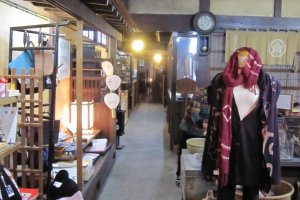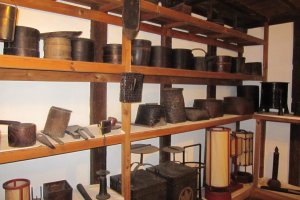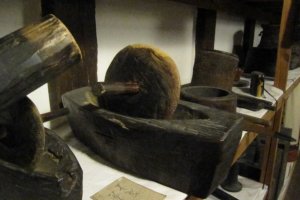Have you ever wondered how people lived without coolers, watches, and iProducts? In downtown Gujo-Hachiman, there is Omodakaya Mingei Museum: The museum of Family Folkcraft. Though the front is a store selling local crafts, art and converting Kimono into western style fashion, the real treat is the back gallery containing tools from the late Edo and Meiji period collected by the Mizuno Family over three generations.
At first I thought I was just visiting a store, but was soon led down a narrow hall to the back where the guide introduced the main gallery. I wouldn’t call it a gallery in the modern museum sense. It is essentially the family kura or storehouse. These are white thick-walled buildings commonly found behind old houses in Japan. They are designed to protect the family treasures from fire and theft. They have 40 centimeter thick walls, steel inner doors and thick sand-filled outer doors. If there is a fire, families would shut up the kura, seal the vent at the base, keeping everything safe till the fire had been extinguished. This dingy storehouse is the museum gallery.
The Omodakaya museum was started by the current owner’s grandfather. He was not rich nor was he interested in collecting valuable items. He loved collecting everyday items like bowls, handcuffs, clocks, and storage boxes.
There are three galleries, two on the first floor and one on the second. The first gallery includes farming, commerce and tools for making shoes or for use in the kitchen. The second gallery features more technical items such as a still-functioning clock from the Meiji period and picnic equipment. One of my favorite items was the sake distributer and cooler. It thought it was a press! On this floor they do have some glass cabinets with some amazing items. The Enku statue is probably one of the most amazing. Enku was an Edo period buddhist monk who walked all over Gifu (and Japan) carving small wooden statues of Buddha. Having read about Enku and his adventures, seeing this made me giddy.
Back on the first floor in the final gallery are some iron items in glass showcases including Meji-period handcuffs and guns.
The lives of the nobel class have been very documented and their items have been perserved in national museums. But the stories and tools of the common farmer, getta maker, miller, housewife and constable are rarely told. At the Omodakaya Folkcraft Museum, you can imagine how they lived day to day.




































